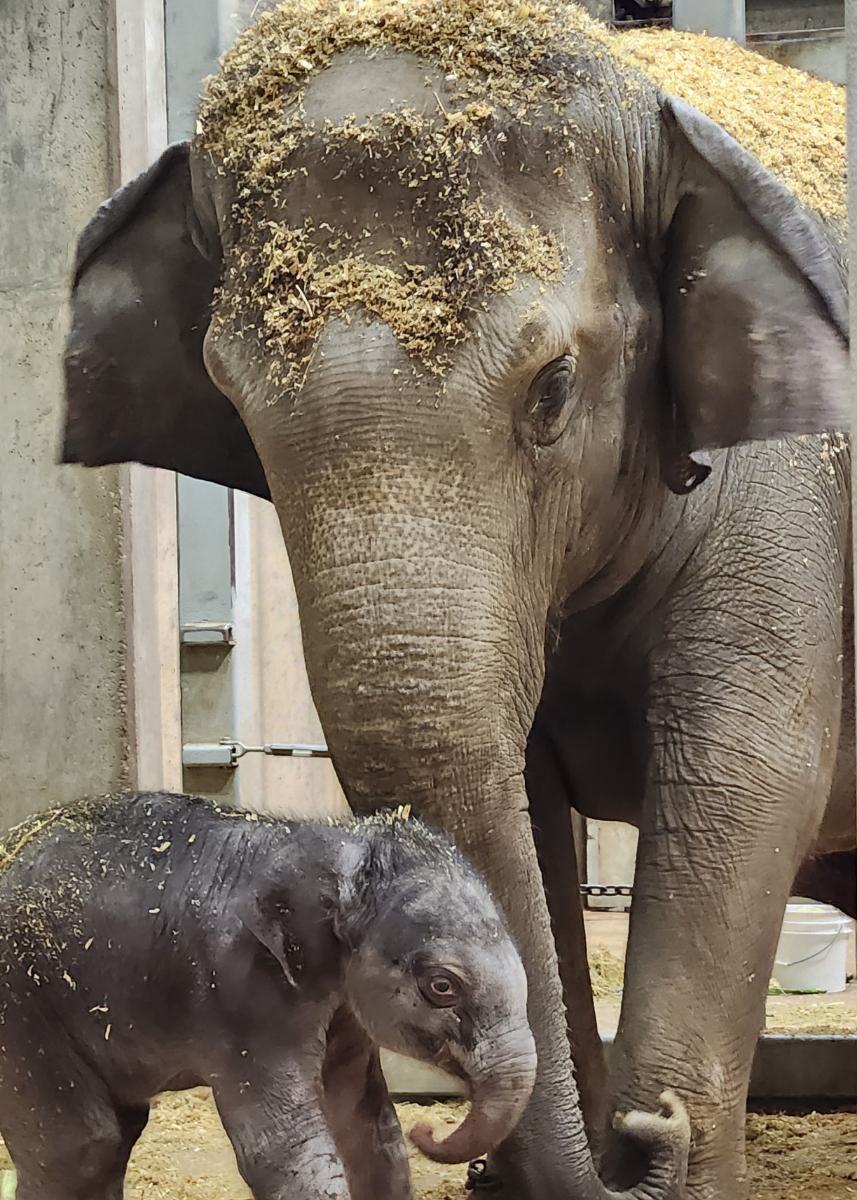St. Louis, MO (Nov. 24, 2024) The Saint Louis Zoo is proud to announce the birth of a male Asian elephant calf at 4:32 a.m. on Saturday, Nov. 23, 2024. Jade, the Zoo’s 17-year-old Asian elephant, gave birth to a baby boy named Jet by the Elephant Care team. Follow updates at stlzoo.org/BabyElephant.
Jet is a gemstone and in line with the Zoo's elephant family history of gemstone names. The calf’s great grandparents are Onyx and Pearl and his mother is Jade.
“We are thrilled to welcome this calf, which starts the fourth generation of our Asian elephant family at the Zoo,” said Tim Thier, Curator of Mammals/Ungulates and River’s Edge, and Director, Saint Louis Zoo WildCare Institute Center for Asian Elephant Conservation. “Jade and baby are doing well and bonding.”
This is the first Asian elephant birth from artificial insemination at the Saint Louis Zoo. The father is Jake, who was born at African Lion Safari in Ontario, Canada, and currently lives at Denver Zoo Conservation Alliance in Denver, CO. The Saint Louis Zoo is committed to improving the sustainability of the Asian elephant population. Using the science of artificial insemination allowed Jade to contribute to the genetic diversity of the population while remaining with her family group.
“Being able to breed and raise a baby is an important part of animal wellbeing and one of the priorities of our thoughtful and robust Animal Care program,” said Regina Mossotti, Vice President of Animal Care, Saint Louis Zoo. “Our incredible and experienced Animal Care team is providing exceptional around-the-clock care for Jade and her newborn calf.”

An elephant pregnancy lasts about 22 months, and a newborn typically weighs about 250-350 pounds. Jade received regular prenatal health checkups throughout her pregnancy by the Zoo’s elephant care team.
Jade is part of an eight-member, four-generation elephant family that includes her new calf, Ellie, Maliha, Pearl, Priya, Sri and Raja at the Zoo’s River’s Edge and Staenberg Group Elephant Woods habitats. Jade was born at the Saint Louis Zoo in 2007 to parents Rani and Raja.
Mother and baby are bonding off public view. When the calf is older and temperatures are warm enough, baby will be able to explore his outdoor habitat. This date has not been set.
Species Survival Plan
This elephant breeding was recommended by the Association of Zoos and Aquariums Asian Elephant Species Survival Plan (SSP), a national cooperative breeding and management program responsible for maintaining a genetically healthy and sustainable population of Asian elephants in North American zoos. The SSP includes recommendations for assisted reproduction techniques like artificial insemination that can benefit the population, even while animals do not reside together. The Denver Zoo Conservation Alliance is a leader in male elephant research that has contributed to advancements in assisted reproductive technologies. This birth is the second successful birth from the institution’s semen collection program.
Asian Elephant Conservation
There are less than 50,000 Asian elephants left in the wild, and they are facing extinction due to habitat loss and poaching. Given the shrinking population of Asian elephants, the Saint Louis Zoo is committed to conserving this endangered species. The Saint Louis Zoo WildCare Institute Center for Asian Elephant Conservation supports the welfare and conservation of Asian elephants in Sumatra and other Asian countries. The Saint Louis Zoo WildCare Institute Center for Conservation in the Horn of Africa also supports the conservation of African elephants in Kenya through the Northern Rangelands Trust. North American population of Asian elephants acts as an assurance population for their wild counterparts, to help ensure the future of this important species.
Leaders in EEHV Detection and Testing
The Saint Louis Zoo has been a leader in pursuing the latest elephant endotheliotropic herpesvirus (EEHV) detection and testing protocols. EEHV is a recent discovery, identified in 1995 by researchers at Smithsonian National Zoo. Since its discovery, the virus has been identified in the wild in both African and Asian elephants. Elephant calves are highly susceptible to EEHV, a viral infection shown to be fatal to wild elephants and elephants in human care. In 2021, the Zoo joined together with other North American elephant facilities in actively supporting EEHV research efforts with its own Polymerase Chain Reaction Laboratory. This allows expert Zoo team members to test samples within a few hours of collection. Early detection and recommended treatments have been made possible because of ongoing research at accredited zoos and reputable elephant care facilities. Recently, a groundbreaking new vaccine for EEHV was released for Asian elephants.
About Saint Louis Zoo
Home to over 16,000 animals, representing nearly 500 species, the Saint Louis Zoo is recognized worldwide for its innovative approaches to animal care and management, wildlife conservation, research, and education. One of the few free zoos in the nation, the Saint Louis Zoo is the most-visited attraction in the region. Accredited by the Association of Zoos and Aquariums (AZA), the Saint Louis Zoo is part of an elite group of institutions that meet the highest standards in animal care as well as provide fun, safe and educational family experiences. The Saint Louis Zoo and the other AZA-accredited institutions collectively dedicate millions of dollars annually to support scientific research, conservation and education programs. For more information, visit stlzoo.org.
###

